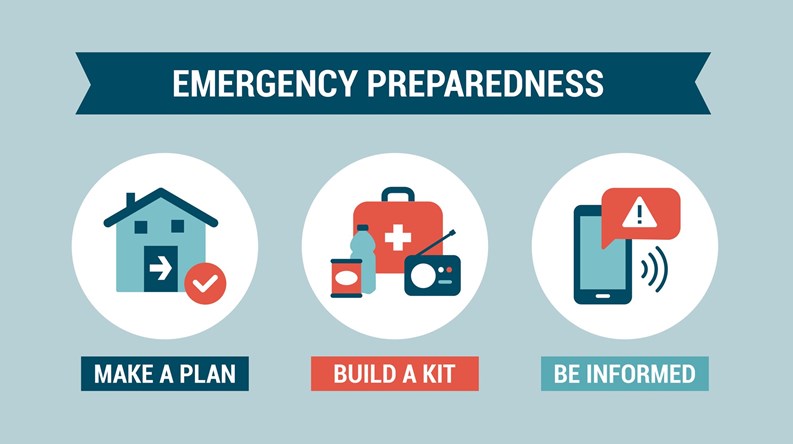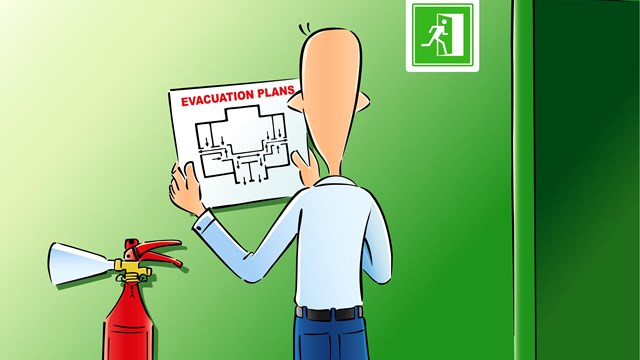They say you can always count on death and taxes, but there’s another not-so-pleasant inevitability that should probably be added to that old axiom: emergencies. And while some may be relatively minor—a fallen branch on an electrical wire, for example—the more significant ones, like fires, severe weather events, and the like are what make headlines. For residents of co-ops and HOAs, being prepared and knowing what to do when calamity strikes is often based on the direction of the board and/or management company.
Maxi- & Mini-Crises
The “true definition” of an emergency, says Christopher R. Antonacci, managing partner at the Freehold-based management company Association Advisors NJ, is anything that threatens property, life, or limb, which is why he says it’s critically important to have a plan in place that residents and management can follow. “It’s up to the manager or onsite staff, like the concierge at high-rise buildings—all those folks are aware and trained. They are the first line of defense,” he says.
“We endured Hurricane Sandy, which led to a lot of angst and damage, especially to our shore-based communities,” Antonacci adds. “We lost one or two building roofs.”
On the other side of the spectrum are situations like roof leaks or plumbing issues, which, while usually less dramatic than a hurricane or fire, can pose serious problems in high-rises if they’re not recognized and dealt with quickly. Antonacci’s firm manages over 100 properties, 30 percent of which are considered high-rises, so “things like leaks can sometimes be a daily occurrence,” he adds.
According to New Jersey Connect, Inc., a 501(c)(3) non-profit organization dedicated to the housing needs of people with physical disabilities, state, county, and local officials recommend that all residents should prepare for an emergency by identifying accessible transportation, designating a safe meeting point, and putting together an emergency kit with necessary items like medications, non-perishable food, bottled water, a change of clothing, hygiene items, cash in small denominations, and a battery operated radio, which should be stored somewhere easily accessible in case of a sudden evacuation.
However, even the best prepared communities can sometimes be caught off-guard, says Thomas Chilenski, president and senior property director for the Fairfield-based Cedarcrest Property Management. “You always have a disaster emergency plan in place, but a lot of times you can’t predict when it’s going to happen—like Hurricane Ida in 2021, which wasn’t expected to be as bad as it was,” he recalls. “We had 10 inches of rain in three hours. You can watch the weather forecast, but you can’t bank on it.”
Not unlike Antonacci’s experience with Hurricane Sandy, which hit in late October of 2012, Chilenski says many of his firm’s 65 properties were impacted by Ida.
“Anytime there is a serious storm situation like a hurricane or flood, at least a few of our properties get hit,” he says. “With Superstorm Sandy, four or five of our properties took a lot of damage, with some basements and boiler rooms all under water…gas meters, electrical panels were all ruined.” And that meant that residents either had to temporarily relocate to drier lodging, or stick it out at home and make do without key utilities until repair crews were able to get things dried out and back online.
Getting Ahead of the Emergency
Property and crisis management pros alike agree that every multifamily community, regardless of size, should take it upon itself to draw up a formal emergency evacuation plan—but in many municipalities, it’s the law, Antonacci says.
“It is mandated from city to city,” he says. In municipalities where emergency plans are mandatory, “[The city] will work with you on it, so local authorities, such as the fire marshal and those types of folks walk the building with the management and board, then come up with an evacuation plan.”
In municipalities that don’t mandate formal plans, Antonacci still strongly encourages all boards—especially in high-rise buildings over five stories—to have a plan in place. “At the end of the day, even smaller buildings must have clearly lit exit signs” and proper signage indicating escape routes and meet-up points.
Chilenski and his team also work closely with local officials to develop sound emergency plans for client communities. “Every property has to have its own plan, because every property is different,” he says, noting that his firm’s portfolio is varied, with a mix of post-war garden buildings, townhomes, and high-rises.
While Chilenski says he personally believes that conducting real-time drills with residents as part of a community’s emergency plan is an “excellent idea,” he says most properties don’t—primarily because of the logistical difficulty of organizing a community-wide exercise, and because of residents’ resistance to the hassle and disruption of participating in one.
“We always strongly recommend it,” he says, “but at the end of the day, we work for the board of trustees of the property, and if they don’t take our advice or agree with our opinion, our hands are tied, so to speak.”
Antonacci says he has had similar experiences, noting that drills and the like are difficult to implement at scale. He’s seen the notion be met with derision by boards, and be a non-starter with residents. And besides, he continues, “we’ve tried it—but in a condo, you can’t force folks to comply with a fire or other evacuation drill.”
Education + Communication
Given the importance of having a well designed emergency plan and the impracticality of conducting periodic real-time drills with residents, Antonacci says that education and good communication are the crucial final pieces of a community’s emergency preparedness plan. For the former, he suggests that community administrators take a crisis management course—one offered by either their management company, their town or city, or a third-party organization.
“We offer [preparedness courses] through some of our business partners,” Antonacci says. “It’s not mandated, but I think it’s a great thing to do. We recommend that the property managers and at least two board members take part in these classes.”
Courses typically run about six hours, and post-pandemic, the vast majority are held online, making them much more convenient for busy managers and board members.
In Chilenski’s experience, it is the 55-and-over ‘active adult’ communities that are most proactive when considering emergency planning best practices.
“People are retired, and they really take these things seriously and put in the time and effort,” he says, “because at the end of the day, they are all unpaid volunteers. If they are not retired and have a job and a family, that takes precedence.”
Help’s On the Way
Regardless of the type of plan being drafted, Antonacci says he and his team prefer to act as liaison between the board, emergency experts, and any other related affiliates involved in the process—simply because of their professional familiarity with both the physical property itself and with other, less material aspects, including any residents who may need additional assistance in an emergency because of their age, physical ability, or other factors.
“With the experience we have, we can be more effective in speaking to those folks directly on behalf of an association,” says Antonacci.
To eliminate any doubt about whether a community is in line with applicable city or county mandates, Antonacci says boards should consult their legal counsel, especially if requirements have been amended or new ones added.
And if a board is set on requiring residents to participate in real-time drills, “the association’s attorney would have to draft some sort of amendment or resolution to the governing documents that would give the board the authority,” he says—and that amendment would have to be put to the residents for approval through a vote.
According to Chilenski, it’s more usual for attorneys to get involved in the immediate aftermath of a crisis than beforehand. “Lawyers don’t come into play until after the fact,” he says. “If you have a disaster and you are trying to apply to FEMA for remediation funds, or if you’re getting a loan from the SBA or other institution to rebuild damage that wasn’t covered by insurance, that’s when [the association’s legal counsel] gets involved.”
Depending on the property and the type of insurance it carries, residents may receive assistance if they’re forced to relocate after a crisis, Chilenski notes—though usually that cost is the residents’ responsibility.
“The Red Cross is also helpful in situations like that, providing temporary housing, food, and clothing,” he adds. “So if it’s a really bad disaster, that’s the first call we make asking for help.”
That said, Antonacci says, “if there is a flood or fire damage, we don’t waste time worrying about the insurance companies—we take action right away getting the contractors in place and communications companies out there right away. Then we work on the insurance piece. We want to first make sure people and their properties are safe and are not further damaged.”
With extreme weather events becoming more frequent and more intense, and the threat of fire a constant concern in multifamily buildings, having a plan for major emergencies is among the most important duties community administrators have. And with more mundane—but no less urgent—issues like leaks, broken elevators, or fallen branches a near everyday occurrence in densely populated associations, being prepared to handle the smaller stuff is part of the job as well.
W.B. King is a freelance writer and contributor to CooperatorNews.







Leave a Comment